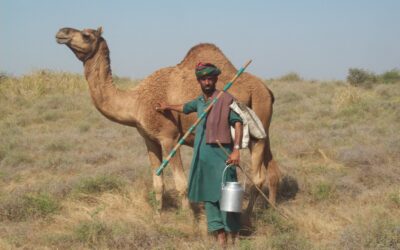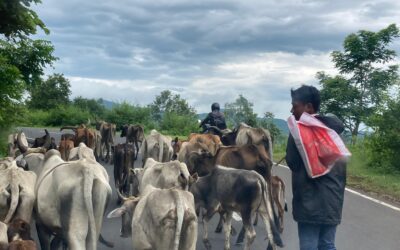Imagine leaders from various political parties traveling to villages, even the smallest talukas, and engaging with people regularly. That’s a rare sight to behold, isn’t it? It’s only when elections are around the corner that we see the greatest of them, bowing down to the people of India. This year’s biggest event – India’s Lok Sabha elections recently got concluded in May and the results were declared in June.
While we talked a lot about who would win the biggest seats and who would form the government, little was talked about the millions of people who made the elections happen. Conducting elections in a country that spans 3.3 million square kilometers, and adheres to a rule that mandates a polling booth within 2 kilometer of every habitation is not an easy task.


According to Reuters,
“The process involved over 15 million people, four hundred thousand vehicles, nearly 1,700 air sorties and 135 trains moving across the country.”
Yet many of us may not even know one out of those 15 million people. We often tend to overlook the millions of people who work tirelessly to ensure we exercise our right to vote. Recently, I had a chance to meet one of them in Sagroli village of Maharashtra, Sachin. Sachin is a computer instructor at a government school in this village which comes under Maharashtra’s Biloli taluka. This year, he traveled 210 kilometers to Kinwat Taluka and proudly served the nation by fulfilling his election duty. The experiences he shared with me revealed the immense effort and dedication required to conduct elections in India.
Before Polling Begins
He started by explaining his journey from the village till Nanded where they were given training and important instructions. Sachin’s election day was April 26th, but he was called to the Nanded district on the afternoon of April 24th. Along with almost 5,000 other teachers, Sachin underwent training based on their roles. Till then nobody in the unit knew which polling booth they were going to get, it was only revealed the next morning.
The first thing they do after knowing their polling booth is grab everything they need, including their personal luggage, as once the booth is known they are not allowed to step out. Along with that, he mentioned that they need to collect the essential election material: three ballots boxes, one VVPat box, a control unit, and a bag filled with nearly 50 pages of forms. “No one from the same taluka is allotted duty in one booth,” he explained. “In fact, we do not know each other until we reach the place.”


“The first day when we carry our bags, we feel so positive and motivated,” Sachin shared. “We say among ourselves that we will do our best; it is our national duty. However, the immense pressure that we feel during the polling process leads to a lot of frustration. Due to the isolation and seclusion, this anger frequently gets misplaced on one another.”
The Election Day Grind
Sachin’s duty was to verify voters’ identities against a list of names, numbers, and photos, using documents like Voter cards, Aadhar cards, or driving licenses. His colleague recorded the serial number, voter information, and took the voter’s signature. He also shared instances where people came with documents showing a different name than what was on the voter list, insisting they were the rightful voters. “They often complain that the print is wrong,” he explains.
Another common issue is voters wanting to bring their mobile phones into the polling booth, which is not allowed. “We have to ask them to leave their phones with us before they can proceed to vote,” he says.
He then described the challenges he faced. Even during lunchtime, as voters continue to arrive, they have to eat with one hand and continue working with the other.
“In many villages, voter turnout is only 20-30%, yet we must remain at our posts all day. We struggle to eat properly, standing in line to grab a quick meal”
Enduring the intense heat, rush, and the constant burden of their equipment, like heavy rucksacks, adds to the physical strain. Accommodations are typically basic, in modest government schools. “Sometimes, I wished I could just run away from there.”
The Aftermath
After the polls close, they have to submit the machines and forms in specific units, a process that takes hours. Sachin reached the submission unit at 11pm, and it took until 1am to complete the submissions. Only then could they eat their first meal since 11:30am. When it was time for them to leave and be relieved, he said, “Our supervisor informed us that there were some queries in the form. Hence, the SDM madam has instructed not to release anyone.” Consequently, they had to painstakingly fill out the forms again starting at 1:30am. Although not everyone was involved, the buses were halted, delaying their return. It wasn’t until 4 in the morning that they finally departed from Kinwat for Nanded after completing the entire paperwork all over again.

The Hidden Struggles
What he shared next revealed the immense physical and mental toll on election workers. “It is a lot of mental harassment that we go through. We get so angry at the people who do not come to vote because we go through all this only for them, it was so hot there. There was no light, and there were mosquitoes outside- we barely got to sleep. We just felt – एक बार ख़तम हो जाए और हम यहाँ से निकल जाएँ “ he expressed.
Reflecting on his experience, he concluded, “I believe the voting hours should be reconsidered. Voting should end at 2pm. Allowing voting from 7am to 6pm and sitting for 11 hours straight is too taxing for us. I also strongly feel that voting should be made compulsory.” Nonetheless, he felt proud sharing each and every detail. He also mentioned that it was his fifth election duty, “I have served in Lok Sabha, Vidhan Sabha, Gram Panchayat elections before”.


The Bigger Picture
Sachin’s story, although eye-opening, is just one of the many. In this year’s elections, officials trekked 39 kilometers to a village in Arunachal Pradesh to collect the vote of a single female voter. Conducting an election in India is not an easy task, and millions of people like Sachin dedicate their time and effort to make it happen.
So, the next time we stand in the line to vote, I hope we remember the effort that goes into ensuring that we get our right to vote. The largest elections in India could only be made possible by these unsung heroes of our electoral system.
References
- BBC News. (2023, March 24). India’s mammoth election: Explained. Retrieved from https://www.bbc.com/news/world-asia-india-68678594
- Reuters. (2023). India elections: Economy in focus. Retrieved from https://www.reuters.com/graphics/INDIA-ELECTIONS/gdpzmqgrmvw/
- The Guardian. (2024, April 18). India’s mammoth election explained: Narendra Modi and BJP. Retrieved from https://www.theguardian.com/world/2024/apr/18/india-mammoth-election-explained-narendra-modi-bjp
- The Indian Express. (2023, November 7). How India’s polling stations work: An expert explains. Retrieved from https://indianexpress.com/article/explained/expert-explains-india-polling-stations-work-9325944/lite/




0 Comments